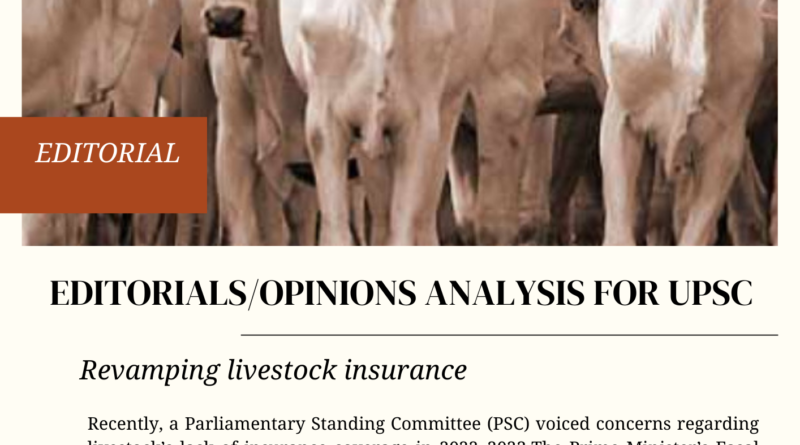Editorials/Opinions Analysis For UPSC 17 April 2023 Ias Banenge
Editorials/Opinions Analysis For UPSC 17 April 2023
Contents
- Revamping livestock insurance
- Long-term funding for civil society organisations
Revamping Livestock Insurance
Context
Recently, a Parliamentary Standing Committee (PSC) voiced concerns regarding livestock’s lack of insurance coverage in 2022–2023.The Prime Minister’s Fasal Bima Yojana is the inspiration for the Center’s proposed comprehensive livestock insurance programme.
Relevance:
GS Paper-2: Government Policies and Interventions for Development in various sectors and Issues arising out of their Design and Implementation.
Mains Question
Describe the proposed comprehensive livestock insurance plan and the steps the centre has taken to boost enrollment. Draw attention to the issues brought up by the Parliamentary Standing Committee on Agriculture and Animal Husbandry and offer solutions. (250 Words)
Scheme for Livestock Insurance
- Class: Centrally sponsored programme.
- Launch: It was implemented as a pilot project in 100 chosen districts during the 10th Five Year Plan’s 2005–2006, 2006–2007, and 2007–2008 periods.
- The programme is being regularly implemented in 100 chosen districts across the nation as of 2008-2009.
- Goal: o To safeguard farmers and cattle farmers against any potential loss of their animals due to death and to show the value of livestock insurance.
- Implementation: The State Livestock Development Boards of each state are responsible for carrying out the scheme, with the exception of Goa.
- Coverage: o Under the plan, crossbred, high-yielding cattle and buffaloes are insured for the highest amount possible based on their current market value.
- The programme offers coverage for a maximum of two animals per beneficiary for a period of three years.
- A 50% subsidy is applied to the insurance premium.
- The Central Government is paying the full cost of the subsidy.
Current Status of Livestock Insurance Scheme:
- The current livestock insurance scheme, which is operational in 100 districts of the country, is managed by the respective State Livestock Development Boards.
- However, less than 1% of the country’s cattle population is insured, and the average yearly premium is 4.5% of the insured amount.
Key problems with livestock insurance programmes include:
- High policy premium rates, which deter many farmers from signing up for livestock insurance programmes.
- Many farmers, especially those from economically depressed sections, cannot afford the average annual premium, which is 4.5% of the insured amount.
- The necessity of comprehensive crop and livestock insurance: Livestock insurance is essential for farmers and the expansion of the agricultural industry.
- Two lakh cattle died as a result of the recent Lumpy Skin Disease pandemic, prompting farmers to ask the government for compensation.
- To lessen the effects of such pandemics, a comprehensive livestock and crop insurance programme is required, covering all facets of animal husbandry and agriculture.
- Conflicting governance structures: Farmers are frequently involved in conflicts between state government representatives and insurance companies. This delays the resolution of claims and worsens the situation for farmers.
- Because each State Livestock Development Board oversees the current programme, there are administrative delays and inconsistencies in the program’s execution.
The Parliamentary Standing Committee made the following recommendations:
- It advised the Ministry to take decisive action to simplify the livestock insurance procedure.
- The Committee recommended looking into the possibility of creating a Livestock Insurance facility for owners of livestock through an app.
- It also raised concerns about the lack of insurance in 2022–2023 and suggested that the Ministry take concrete steps to simplify the insurance of livestock for beneficiaries.
The Proposed Scheme for Livestock Insurance
- The Ministry intends to replace the current Livestock Insurance Scheme with a comprehensive livestock insurance programme.
- Recently, the Ministry met with various insurance providers and other interested parties to discuss the issue. The objective is to lower the premium so that more farmers sign up for the programme.
- Due to the high policy premium rates and general economic conditions of farmers, the Centre is considering eliminating the premium for cattle rearers from Scheduled Caste (SC)-Scheduled Tribe (ST) communities.
- The Ministry prefers direct transfer of benefits to farmers’ accounts, while the Centre works to keep premiums low and ensure that livestock are covered to the greatest extent possible. Benefits will be transferred directly, improving transparency and simplifying the process for farmers.
Conclusion:
- The proposed comprehensive livestock insurance scheme aims to increase the coverage of livestock and lower the premium rate.
- Livestock insurance is essential for the financial security of farmers who are engaged in livestock farming.The need for a strong insurance programme to safeguard farmers’ interests is highlighted by the recommendations of the Parliamentary Standing Committee and demands from farmers’ organisations for comprehensive livestock and crop insurance.
Long-Term Funding For Civil Society Organisations
Context
- With some notable exceptions, most donors’ time horizons and their roles in India have shrunk over the last two to three decades.
- Because donors’ actions and inactions have a significant impact on the CSO landscape, this has had a cumulative weakening effect on Indian civil society.
Relevance:
GS Paper-2: Development Processes and the Development Industry — the Role of NGOs, SHGs, various groups and associations, donors, charities, institutional and other stakeholders
Mains Question
Donor actions or inactions have a significant impact on the landscape of civil society organisations (CSOs). Review the assertion. Also, make some recommendations for ways to enhance the CSOs’ efficiency and effectiveness. (150 Words)
READ MORE – About Preventive Detentions In India Ias Banenge
Civil society Organizations
- Non-governmental organisations (NGOs), community-based organisations (CBOs), and other types of not-for-profit organisations that work to improve society and assist the vulnerable are all considered civil society organisations (CSOs).
- Civil Society Organisations (CSOs) are structured voluntary non-state institutions that primarily run on a non-profit basis and represent a wide range of interests and connections.The majority of CSOs engage in two types of work.
- The first step is to create and maintain institutions that benefit the community in some way, such as orphanages, homeless shelters, facilities that support women’s collectives, and (commonly seen) health clinics and schools for the underprivileged.
- The second category includes actions taken to improve a particular aspect of a community, such as small farmers’ livelihoods, environmental sustainability, access to entitlements like ration cards or income from the forest, or the operation of rural panchayats.
Problems with CSOs include:
- Inadequate Support for CSO Overheads o Most donors anticipate a robust, active, and high-capacity CSO ecosystem.
- However, it is not consistent with that expectation to show resistance to the initiatives and jobs that guarantee organisational stability.
- Donors prefer to support expenses incurred for projects and initiatives that directly benefit the communities for which they are intended.
- They don’t want to, or they want to minimise, their support for the additional expenses CSOs would incur, which are loosely referred to as “overheads.”
- Reluctance to Commit to Long-Term Funding o Three decades ago, a lot of donors were willing to give CSOs corpus grants or long-term grants of 7–10 years duration.
- However, a lot of CSR donors now only provide one-year grants, whereas other donors typically provide three-year grants.
- Grants with a longer duration are an exception, and only a few philanthropic foundations support them.
Negative effects on CSO operations include:
- Inadequate funding for overhead costs
- Without taking care of overheads properly, no organisation can function.
- These “overheads” are supported by almost all donors, though a disproportionate number do so reluctantly and insufficiently.
- The unjustified push for powerful CSOs with no overheads is one example of this funding gap.
- Resistance to Long-Term Funding o Both types of work are incompatible with short-term funding from donors.
- Institutional work requires ongoing financial support—as long as the community requires the assistance given.
- Institutions will therefore need to carry on operating and performing their duties in order to support communities.
- Even at the modest scale of a few villages or urban communities, intervention-type work typically takes 5 years, and frequently 7.
- This is due to a variety of factors, including the length of time it takes to assemble a CSO team with sufficient resources, win over communities’ trust, develop a shared understanding of the particulars and complexity of the problem to be addressed, enable the first few changes, deal with inevitable resistance, disseminate those changes, and maintain them through cycles of disappointment and failure.
- The processes by which human behaviour and communities change are extremely gradual, unpredictable, and fraught with complications and unintended consequences.
- Even in intervention-type work, improvements may eventually be wiped out or diminished by opposing forces unless institutional support for community changes is maintained.
- It is sufficient to note that donors’ short-term grant commitments to CSOs are incompatible with the core principles of their work.
- At its core, it causes a great deal of uncertainty, which directly affects the work because it affects the stability of the teams on the ground, the way the work is approached and designed, the activities that are carried out, and ultimately the calibre of the work.
- Instead of concentrating on actual work, the organization’s leadership is frantically trying to raise money; frequently, this takes up more than half of their time.
- Even more cunningly, these condensed time frames force CSOs to frequently prioritise what they can “show” the donor during that time rather than what is actually needed.
- At its core, it causes a great deal of uncertainty, which directly affects the work because it affects the stability of the teams on the ground, the way the work is approached and designed, the activities that are carried out, and ultimately the calibre of the work.
- This kind of short-termism has been weakening CSOs over time and directing their work in a superficial and shallow direction.
Way Forward
- The best course of action is for all donors to demand and demand that funding be granted only after they have seen the quality and progress of the work.
- This is fully justified, but the same results can be obtained by allocating long-term funds, for example, for seven years, with the entirely reasonable expectation that such financial support is conditional on satisfactory progress.
- In reality, many donors might not find this challenging because they frequently extend their grants after the initial funding period.
- Such a shift by a sizable number of donors will have a significant impact on the CSO ecosystem, both in terms of the quality of work because it will be planned and carried out with realistic timeframes, enabling work that is truly necessary, and in terms of the quality of organisations because it will strengthen them and assist them in building greater capacity.
Conclusion:
Civil society organisations (CSOs) are crucial to the nation’s social, economic, and democratic advancement.





Pingback: Current Affairs 17 April 2023 Ias Banenge - Ias Banenge